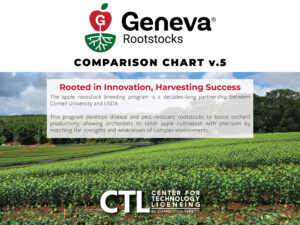We are working on a new and reformed plant varieties catalog where you can learn about Cornell plants and the process of licensing them. In the meantime, review this page to get a broader introduction of all we have to offer.
Plants
Coming Soon!
Fruits:
Apples
Apple Rootstocks
The joint Cornell University and United States Department of Agriculture-Agricultural Research Service (USDA-ARS) Apple Rootstock Breeding and Evaluation Program develops new rootstock cultivars with an emphasis on ease of nursery propagation, fireblight resistance, tolerance to extreme temperatures, resistance to the soil pathogens of the sub-temperate regions of the US, and tolerance to apple replant disorder.

Introducing our new Geneva® Rootstocks logo—a symbol of innovation and resilience in apple cultivation. This redesigned trademark embodies the precision and care that defines our Geneva® Apple Rootstock program, a result of decades-long collaboration between Cornell University and the U.S. Department of Agriculture. The logo reflects our commitment to providing apple growers worldwide with disease-resistant rootstocks tailored to specific environments. When you spot the Geneva® logo in an orchard, rest assured that the apple scions are fortified by meticulously designed rootstock, ensuring optimal growth and protection.
The Geneva® Rootstocks comparison chart provides a wide range of varieties available for licensing. From disease resistance to environmental adaptability, each rootstock offers unique traits tailored to elevate the apple cultivation experience.
Download the Geneva® Apple Rootstocks comparison chart here.
Apple Scions
- Apple ‘NY56’ CORDERA®
- Apple ‘NY73’ PINK LUSTER®
- Apple ‘NY109’ FIRECRACKER®
Grapes
Since 1888, Cornell viticulturists have introduced more than 45 new table, juice, and wine grape varieties adapted to cool-climate growing regions. Cornell University offers research and educational facilities that positively impact not only local winery businesses and tourism, but also present the world with novel varieties that can provide a sustainable future.
Blue Table Grape
Red Wine
Selections Available for Evaluation
- D6292 Red Seedless Table Grape
- D6293 Blue Seedless Table Grape
- D6294 Red Seedless Table Grape
- D6297 Blue Seedless Table Grape
White Table
White Wine
Melons
The cucurbit breeding program has developed varieties and lines that were selected based upon the following qualities: improved flavor, high nutrition content, production quality, disease and insect resistance, as well as, novel traits.
Honeydew
Raspberries
The primary goal of the small fruit breeding program is to develop improved berry varieties with disease and insect resistance, and fruit quality by traditional breeding practices.
Golden Blush
Red
Bean
Cucumbers
Kale
Pea
Peppers
The pepper breeding program has developed varieties and lines that were selected based upon the following qualities: improved flavor, high nutrition content, production quality, disease and insect resistance, as well as, novel traits.
Potatoes
Cornell’s potato breeding program centers around the genetic improvement of potato, both by conventional and molecular means. The highest breeding priority is to develop agronomically-acceptable varieties that are resistant to the golden nematode. It aims to develop new chipping and tablestock varieties that are adapted to the Northeast, and to meet ever-changing needs of the regional potato industry.
Chipping Varieties
White Skin White Flesh
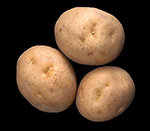 ‘Lady Liberty’
‘Lady Liberty’
Late-season chipstock producing smaller round-shaped tubers with netted skin. Excellent chip color from cold storage. Good-yielding ability. Moderate-to-good resistance to common scab. Suitable for the small-sized snack-pack market. Previously tested as NY152.
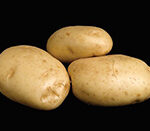
‘Brodie’
Full season maturity chipstock producing large tubers with oblong shape. Smooth white skin with white flesh. Excellent chip color from cold storage. Excellent yielding ability. Resistant to the golden nematode (Ro1 & Ro2). The resistance to both strains is what makes this variety special. Previously tested as NY140.
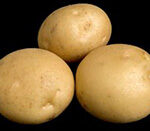 ‘Lamoka’
‘Lamoka’
Late maturity chipstock that produces attractive, round tubers. Specific gravity has averaged 0.004 less than ’Atlantic’. Excellent chip color from cold storage. Good resistance to common scab. Resistant to the golden nematode (Ro1). Previously tested as NY-139.
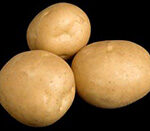 ‘Marcy’
‘Marcy’
Late maturity chipstock. Large vines with white flowers. Tubers have scurfy skin with attractive round shape. Outstanding yield of large tubers. Generally free of pickouts due to external defects, small percentage of internal defects. Resistant to golden nematode and scab. Formerly test selection NY112.
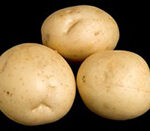 ‘Waneta’
‘Waneta’
Late maturity chipstock. Large tubers with attractive shape and moderately textured skin. In Cornell trials, yield has been comparable to ’Atlantic’, while gravity has averaged 0.01 less than ’Atlantic’. Few pickouts, but large tubers have shown 5 to 10% hollow heart. Very good chip color from 44 degree storage. Dormancy is six weeks longer than ’Atlantic’. Less susceptible to blackspot than ’Snowden’. Moderately resistant to common scab. Resistant to the golden nematode (Ro1). Previously tested as NY138.
‘Bliss’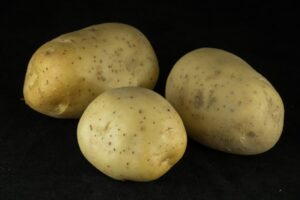
Mid-late season chipstock with exceptionally light chip color out of cold storage and very few internal defects. Specific gravity has averaged 0.004 less than Atlantic. Resistant to race Ro1 of the golden nematode and moderately resistant to common scab. Previously tested as NY163.
Table-stock Varieties
White Skin White Flesh
 ‘Brodie’
‘Brodie’
Full season maturity chipstock producing large tubers with oblong shape. Smooth white skin with white flesh. Excellent chip color from cold storage. Excellent yielding ability. Resistant to the golden nematode (Ro1 & Ro2). The resistance to both strains is what makes this variety special. Previously tested as NY140.
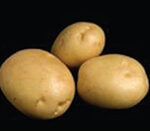 ‘Algonquin’
‘Algonquin’
Early to mid-season maturity white table-stock that features attractive large and oval tubers with a smoother skin than ‘Superior’. Good resistance to common scab. Resistant to race Ro1 of the golden nematode. Previously tested as NY141.
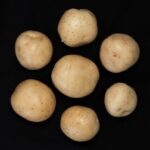 ‘Upstate Abundance’
‘Upstate Abundance’
Early season maturity white table-stock that produces many small round tubers with smooth skin. Resistant to race Ro1 of the golden nematode. Some resistance to common scab and late blight. Previously tested as NY150.
Test Selections for Evaluation and Testing
Squash
The cucurbit breeding program has developed varieties and lines that were selected based upon the following qualities: improved flavor, high nutrition content, production quality, disease and insect resistance, as well as, novel traits.
Butternut
Winter Squash
Tomatoes
- Malting Barley
- Excelsior Gold Spring Malting Barley for evaluation
- Soft White Winter Wheat
Wheat
Wheat research began in the fall of 1907. The goals of the wheat breeding program are to introduce new cultivars and germplasm having improved yield, nutritional quality, disease resistance, and other characteristics that increase the crop value and production efficiency.
Soft White Winter Wheat
Ornamentals:
Alstroemeria
The ornamental varieties are a new frontier for Cornell’s Horticulture Department. The varieties were chosen for characteristics including: unique and unusual leaf and flower colors, insect and disease resistance, as well as, cold tolerance.


